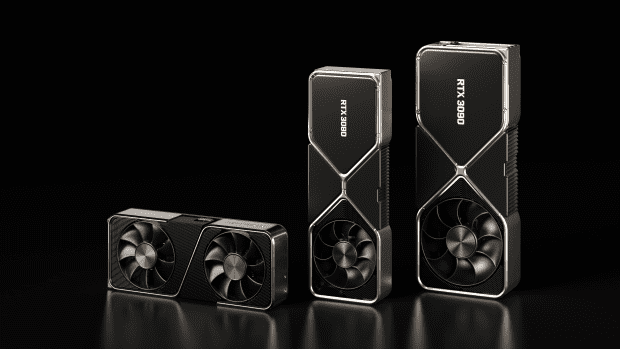This post was originally published on this site

Nvidia
Nvidia Corp. launched its new line of gaming cards on Tuesday, and detailed more games that are taking advantage of the ray-tracing technology that was introduced in the previous line of graphics-processing units.
Based on its Ampere architecture, released in May to replace its Turing and Volta chips with a single platform, Nvidia unveiled a series of gaming cards called the GeForce RTX 3070, the RTX 3080, and the top-of-the-line RTX 3090, which Chief Executive Jensen Huang referred to as “a beast.” Nvidia NVDA, +2.56% is keeping prices steady on its basic and midtier cards while slashing the price of its high end card by $1,000.
Huang announced the new chips in a YouTube video Tuesday morning, similar to his announcement of new Ampere-based server chips in May. The new cards build upon Turing architecture. which brought real-time ray tracing — the rendering of realistic-looking lighting and shading — to the fore. But when RTX ray tracing made its appearance two years ago, critics argued that developers were slow in putting out enough games that took advantage of the technology.
Opinion: Nvidia hits a sweet spot, with both gaming and data center on the rise
Nvidia addressed the games issue by noting that Epic Games’ popular title “Fortnite” was now taking advantage of RTX, along with Microsoft Corp.’s MSFT, -0.34% “Minecraft,” Activision Blizzard Inc.’s ATVI, -0.99% “Call of Duty: Black Ops Cold War,” and CD Projekt’s “Cyberpunk 2077.” The company also said that for a limited time the purchase of a 30-series card would come with a version of Ubisoft Toronto’s “Watch Dogs: Legion” and a free one-year subscription to its GeForce Now cloud-gaming service.
Nvidia said the RTX 3080 will be available Sept. 17, with the RTX 3090 available Sept. 24, and the RTX 3070 “sometime” in October. That will give the company about six weeks of sales of the new cards before Nvidia’s fiscal third quarter finishes up at the end of October.
Nvidia said the $499 RTX 3070 runs faster than its $1,199 RTX 2080 Ti, which is currently listed as out of stock, and up to 60% faster than its original RTX 2070, which was $499 when Nvidia launched its 20-series of Turing-architecture gaming cards two years ago. The upgrade to the RTX 2070, or the “Super” version that came out in July 2019, last listed at $499.
Similarly, the midtier $699 RTX 3080 is up to two times faster than the RTX 2080, Nvidia said. The “Super” version of the 2080 card last listed at $699.
At the high end, however, Nvidia appears to be offering a deep discount on performance. The company said its $1,499 RTX 3090 runs up to 50% faster and 10 times quieter than its flagship Titan RTX, which last listed at $2,499.
Huang said demand for the limited-run Titan “surprised us” as filmmakers were using the Titan to make 4K movies, bloggers used it to build broadcast workstations, and others used the card for applications that required its power.
“There is clearly a need for a giant GPU that is available all over the world, so we made a giant Ampere,” Huang said in his presentation.
See also: Will videogames be the Achilles heel for Apple, Google in antitrust investigations?
Nvidia would not comment on whether it would lower prices on its 20-series Turing cards. At last check, the company is still listing its RTX 2060 Super card at $399.
Less than two weeks ago, Nvidia execs talked a lot about gaming on the company’s earnings conference call even though data-center sales had surpassed gaming for the first time ever, with Huang forecasting “this may very well be one of the best gaming seasons ever.”
Earlier in the year, Nvidia topped Intel Corp. INTC, -0.69% as the largest U.S. chip company by market cap in July and went on to clear a $300 billion valuation for the first time in August. For the year, Nvidia shares have soared 128%, while the PHLX Semiconductor Index SOX, +1.52% has gained 23%, the S&P 500 index SPX, +0.35% has advanced 9%, and the Nasdaq Composite Index COMP, +0.99% has grown 31%.

